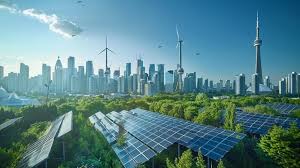In the face of climate change, rising energy costs, and growing urban populations, cities are under pressure to adopt cleaner, more sustainable practices. One of the most impactful ways to do this is by integrating renewable energy technologies directly into the infrastructure of urban environments—both residential and commercial.
This approach not only reduces carbon emissions but also improves energy resilience and long-term cost efficiency for buildings and communities.
? 1. Solar Energy: A Cornerstone of Urban Sustainability
Solar power remains the most widely adopted renewable energy solution in urban areas. Thanks to falling installation costs and improved panel efficiency, solar is now a practical option for:
Rooftop installations on residential and commercial buildings
Solar carports that generate energy while offering shaded parking
Building-integrated photovoltaics (BIPV), where solar panels are part of the building’s façade or windows
Why it works in cities:
Urban areas often have vast amounts of underutilized roof space. Even in cloudy regions, solar energy can generate significant returns over time.
? 2. Wind Power: Small-Scale Solutions with Big Potential
While large wind turbines are more common in rural areas, small urban wind turbines are gaining popularity for localized energy generation.
Ideal for:
High-rise buildings
Industrial parks
Remote or off-grid urban developments
Innovation spotlight: Vertical axis wind turbines (VAWTs) are quieter, more compact, and can be installed on rooftops where traditional turbines can’t.
? 3. Geothermal & Ground Source Heat Pumps
Geothermal systems tap into the constant temperatures beneath the earth’s surface to heat and cool buildings with remarkable efficiency. In densely populated urban settings, ground source heat pumps are being used in:
Multi-family residential complexes
Schools and hospitals
Commercial towers
These systems offer year-round comfort with very low environmental impact.
? 4. Energy Storage Systems: Powering the Grid of the Future
No renewable energy strategy is complete without storage. Battery energy storage systems (BESS) allow buildings to store surplus energy—particularly solar—so it can be used when the sun isn’t shining or during peak demand times.
Urban application:
Storage systems support microgrids in neighborhoods, enabling local power resilience during outages or grid instability.
?️ 5. Microgrids and Distributed Energy Resources (DERs)
Urban areas are shifting from centralized to decentralized energy systems, where buildings generate and manage their own energy. Microgrids allow:
Better integration of solar and wind energy
Shared energy resources across a district
Greater energy independence
They’re especially useful in large residential developments, campuses, or commercial hubs.
? 6. Policy, Incentives & the Developer Advantage
Government incentives such as tax credits, net metering, and green building grants make renewable integration even more appealing. Green infrastructure boosts:
Property values
Tenant retention
ESG performance scores for developers and investors
?️ Real-World Example: A Solar-Integrated Mixed-Use Building
A developer in a dense metro area incorporates rooftop solar, solar glass windows, and battery storage into a 10-story mixed-use development. Over 60% of the building's energy comes from renewables, drastically reducing utility bills and improving the project’s LEED rating.
? The Path Forward
Building green isn’t just about planting trees—it’s about embedding clean energy into the bones of our cities. By integrating renewables into the very framework of urban infrastructure, we can build cities that are not only smarter and more resilient, but also cleaner and kinder to the planet.
Building Green: Integrating Renewable Energy into Urban Infrastructure

